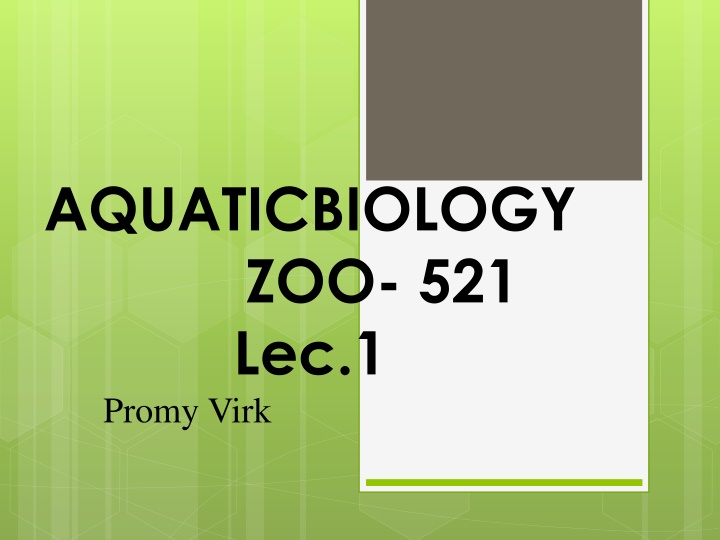
Exploring Aquatic Ecosystems and Marine Environments
Aquatic ecosystems, whether marine or freshwater, are rich in biodiversity and play a crucial role in the planet's ecosystem. This introduction delves into the characteristics of aquatic ecosystems, the importance of marine environments, and the different types of marine ecosystems such as coral reefs, kelp forests, and more. Understanding the differences in salinity levels, marine provinces, and nutrient distribution provides insight into the delicate balance of life within these environments.
Download Presentation

Please find below an Image/Link to download the presentation.
The content on the website is provided AS IS for your information and personal use only. It may not be sold, licensed, or shared on other websites without obtaining consent from the author. If you encounter any issues during the download, it is possible that the publisher has removed the file from their server.
You are allowed to download the files provided on this website for personal or commercial use, subject to the condition that they are used lawfully. All files are the property of their respective owners.
The content on the website is provided AS IS for your information and personal use only. It may not be sold, licensed, or shared on other websites without obtaining consent from the author.
E N D
Presentation Transcript
AQUATICBIOLOGY ZOO- 521 Lec.1 Promy Virk
COURSE EVALUATION Credit Hours- 2 (1+1) First mid term exam Lab Class activity with presentation - 15 marks Final Exam TOTAL - 15 marks 30 marks -40 marks -100 marks
INTRODUCTION AQUATIC ECOSYSTEM An aquatic ecosystem is an ecosystem located in a body of water. Communities of organisms that are dependent on each other and on their environment live in aquatic ecosystems. The two main types of aquatic ecosystems are marine ecosystems and freshwater ecosystems.. Water salinity based on dissolved salts in parts per thousand (ppt) Freshwater Brackish water Saline < 0.5 0.5 - 35 35 - 50
Marine ecosystems cover approximately 71% of the Earth's surface and contain approximately 97% of the planet's water. They generate 32% of the world's net primary production. They are distinguished from freshwater ecosystems by the presence of dissolved compounds, especially salts, in the water. Approximately 85% of the dissolved materials in seawater are sodium and chlorine. Seawater has an average salinity of 35 parts per thousand (ppt) of water. Actual salinity varies among different marine ecosystems.
A. Marine environments can be characterized broadly as a water, or pelagic, environment and a bottom, or benthic, environment. Within the pelagic environment the waters are divided into the neritic province, which includes the water above the continental shelf, and the oceanic province, which includes all the open waters beyond the continental shelf. The high nutrient levels of the neritic province resulting from dissolved materials in riverine runoff distinguish this province from the oceanic. The upper portion of both the neritic and oceanic waters the epipelagic zone is where photosynthesis occurs; it is roughly equivalent to the photic zone. Below this zone lie the mesopelagic, ranging between 200 and 1,000 metres, the bathypelagic, from 1,000 to 4,000 metres, and the abyssalpelagic, which includes the deepest parts of the oceans.
Types of Marine Ecosystem Marine ecosystems types include open deep sea, salt water wet-land, coral reefs, estuary, mangroves, sandy beach, kelp forest, polar marine and rocky marine ecosystem.
Brackish water is water that has more salinity than fresh water, but not as much as seawater. It may result from mixing of seawater with fresh water, as in estuaries.
B. Freshwater ecosystems Freshwater ecosystems cover 0.8% of the Earth's surface and contain 0.009% of its total water. They generate nearly 3% of its net primary production. Freshwater ecosystems contain 41% of the world's known fish species.There are three basic types of freshwater ecosystems: Lentic: slow-moving water, including pools, ponds, and lakes. Lotic: rapidly-moving water, for example streams and rivers. Wetlands: areas where the soil is saturated or inundated for at least part of the time.
An aquatic animal is an animal, either vertebrate or invertebrate, which lives in water for most or all of its life. It may breathe air or extract its oxygen from that dissolved in water through specialised organs called gills, or directly through its skin. Animals that move readily from water to land and vice versa are often referred to as amphibious. The term aquatic can in theory be applied to animals that live in either freshwater (freshwater animals) or marine (seawater animals). In addition to water breathing animals, e.g., fishes, mollusks etc., the term "aquatic animal" can be applied to air-breathing aquatic or sea mammals such as those in the order Cetacea (whales), which cannot survive on land, as well as four-footed mammals like the river otter and beavers.
Aquatic animals include for example the seabirds, such as gulls (family Laridae), pelicans (family Pelecanidae), and albatrosses (family Diomedeidae), and most of the Anseriformes (ducks, swans and geese). Amphibious and amphibiotic animals, like frogs (the order Anura), while they do require water, are separated into their own environmental classification. The majority of amphibians (class Amphibia) have an aquatic larval stage, like a tadpole, but then live as terrestrial adults, and may return to the water to mate. Certain fish also evolved to breathe air to survive oxygen-deprived water, such as arapaima (family Osteoglossidae) and walking catfish
Aquatic Organisms Aquatic organisms generally fall into three broad groups: plankton, nekton, and benthos. They vary in how they move and where they live. Plankton are tiny aquatic organisms that cannot move on their own. They live in the photic zone. They include phytoplankton and zooplankton. Phytoplankton are bacteria and algae that use sunlight to make food. Zooplankton are tiny animals that feed on phytoplankton. Nekton are aquatic animals that can move on their own by swimming through the water. They may live in the photic or aphotic zone. They feed on plankton or other nekton. Examples of nekton include fish and shrimp. Benthos are aquatic organisms that crawl in sediments at the bottom of a body of water. Many are decomposers. Benthos include sponges, clams, and anglerfish
Aquatic Adaptations When animals live in the water, they must have special adaptations to help them survive in an aquatic habitat. The more time an animal spends in the water, the more adaptations the animal will have for an aquatic life. Below are examples of some of these adaptations: 1. Streamlined body reduces friction when the animal moves through the water. 2. Smooth, almost furless body helps aquatic mammals move through the water with little friction. 3. Dense fur helps streamline the bodies of some aquatic mammals and keeps them warm. 4. Dense waterproof feathers keep cold water away from bird's skin and prevent wetting of the feathers. 5. Webbed feet, formed from thin skin between the toes, work like paddles.
6. Long legs and necks keep the bodies of wading birds out of the water and are thin, light, and easy to move, and the long neck helps the birds to reach the water, or below it, for food. 7. Strainers in the mouth filter food particles from the water. 8. Flippers provide a large surface for pushing against water and act like paddles. 9. Eyes positioned on top of the head allow animals to hide almost fully submerged in water and still detect predators or prey above the water. 10. Nostrils positioned near the top of the head allow animals to come to the surface to breathe while only a small part of the body can be seen. 11. Nostrils close when the animal goes under the water. 12. Blubber, a thick layer of fat or oil stored between the skin and muscles of the body, provides insulation. 13. Transparent eyelids cover the eyes of animals swimming underwater. 14. Flattened tails serve as paddles.



![Lec [2] Health promotion](/thumb/274962/lec-2-health-promotion-powerpoint-ppt-presentation.jpg)